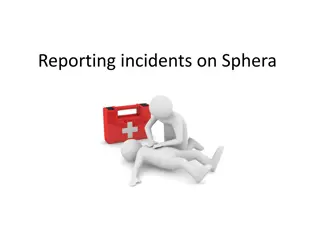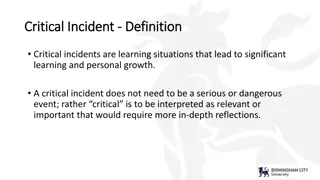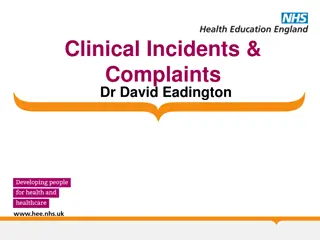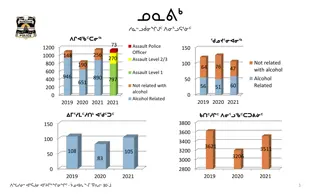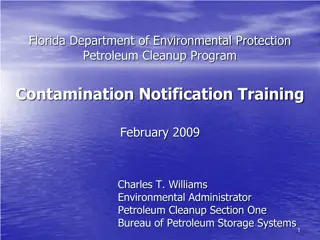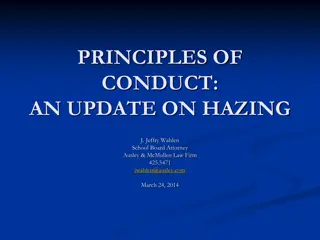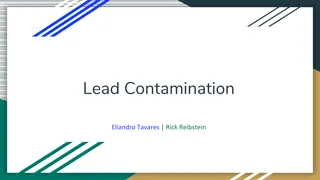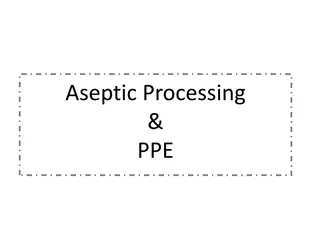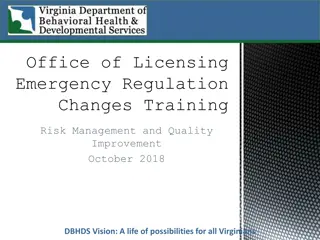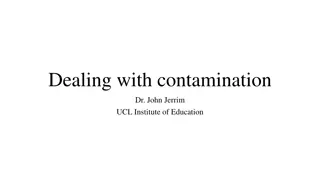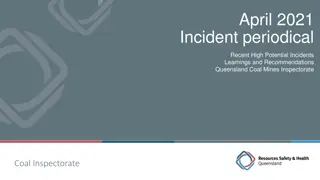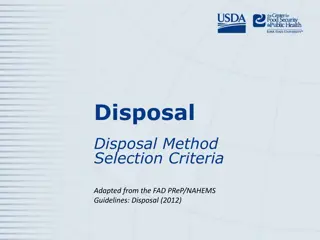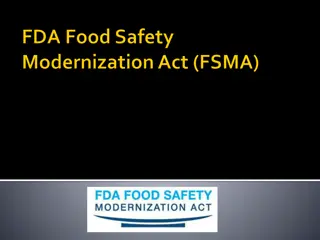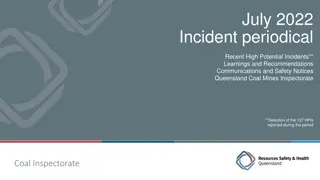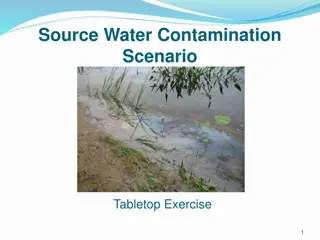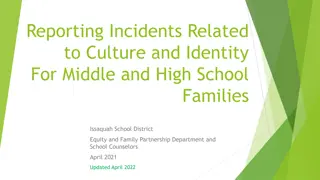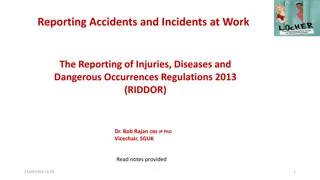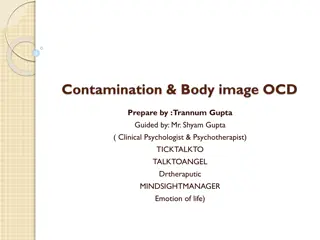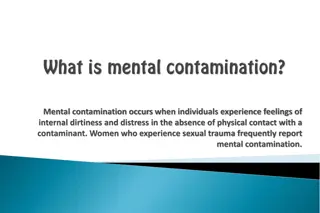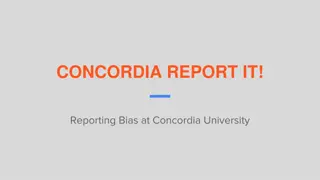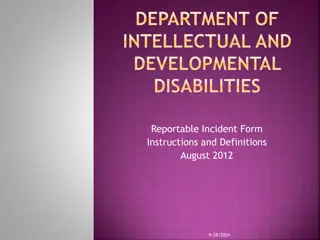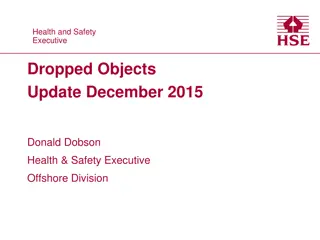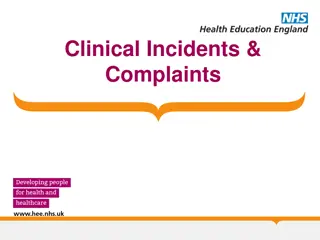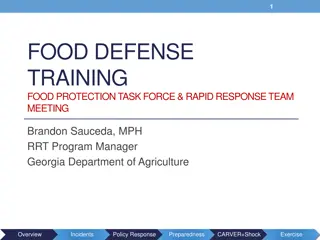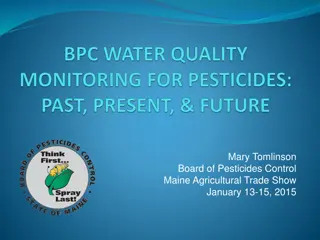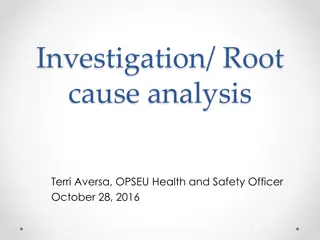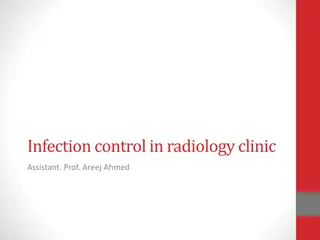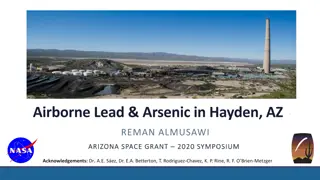Understanding Critical and Non-Critical Incidents in Incident Reporting
Critical incidents, as defined by regulations, are serious events that pose immediate risk to health, safety, or welfare. Non-critical incidents, on the other hand, are minor in nature and do not have serious consequences. Incident reports play a crucial role in documenting occurrences, identifying
0 views • 29 slides
Comprehensive Guide to Initial Operational Response (IOR) in Hazardous Substance Incidents
This guide outlines the objectives, principles, and key elements of Initial Operational Response (IOR) to incidents involving hazardous substances or CBRN materials. It covers the stages of response, transition to Specialist Operational Response (SOR), primary objectives of IOR, JESIP principles, an
4 views • 25 slides
Reporting Incidents on Sphera
The Council utilizes Sphera to manage health and safety risks, requiring employees to report accidents, near misses, violence incidents, and more promptly. This guide explains how to report incidents on Sphera, including accessing the reporting portal, completing mandatory fields, and obtaining pape
9 views • 26 slides
Understanding Critical Incidents for Personal Growth
Critical incidents are integral learning opportunities that can lead to significant personal development. They do not necessarily involve danger but are situations that prompt deeper reflections. The BCU Assessment tracker is used to track progression towards key themes. The associated teacher's pro
1 views • 4 slides
Understanding Food Microbiology: Sources of Contamination
Humans have broader nutritional requirements than most microorganisms. The human diet includes a wide variety of substances, making our food excellent media for microbial growth. Natural contamination of food by various microorganisms, including pathogens, is common. Food consumed by humans and anim
0 views • 51 slides
Process Safety Incidents and Prevention Best Practices
Process safety incidents involving hazardous materials like caustic solutions, ammonia leaks, and TFE have caused injuries and fatalities. Key incidents include burns from caustic exposure, fatalities due to ammonia leaks, and an explosion from improper TFE handling. Learning from these incidents hi
7 views • 21 slides
Safeguarding Your Kitchen: Preventing Cross-Contamination
Cross-contamination poses a risk of foodborne illnesses and can occur in multiple ways, such as using the same utensils for raw and cooked foods. Taking specific cleaning steps at home, like regularly cleaning dish cloths and sanitizing surfaces, is vital to preventing harmful bacteria from spreadin
0 views • 8 slides
Clinical Incidents and Complaints: Understanding, Management, and Prevention
Explore the definition of clinical incidents, learn how to recognize and react to them, understand patient complaints, and discover ways to prevent incidents and complaints in healthcare settings. Discover who to report incidents to and how healthcare organizations handle complaints. Gain insights i
0 views • 12 slides
Analysis of Assault Incidents in Relation to Police Officers
This data presents a detailed analysis of assault incidents involving police officers, categorized by assault level, alcohol-related factors, and year. The data covers non-criminal and criminal incidents, as well as the combined total incidents over the years 2019, 2020, and 2021.
0 views • 36 slides
Contamination Notification Training: Florida Department of Environmental Protection
This document outlines the Contamination Notification Training provided by the Florida Department of Environmental Protection in February 2009. It covers types of contamination notification, governing statutes, rules, and guidance, specific noticing requirements, and changes from prior guidance. The
0 views • 25 slides
Camp and Club Incidents at 4-H Programs
Various incidents occurred at 4-H programs involving negligence, resulting in injuries to participants. From a camper injured by a protruding nail, to an accident caused by a faulty van, and accidents during horse riding and archery activities, these incidents highlight the importance of ensuring sa
0 views • 11 slides
Update on Hazing Incidents in Schools: Consequences and Lessons
Recent hazing incidents in schools have raised concerns, with various cases involving freshmen being subjected to harmful practices by senior students. These incidents have led to legal repercussions, jail time, probation, and community backlash. The stories highlight the importance of vigilance by
0 views • 39 slides
Addressing Lead Contamination: Advocating for Effective Legislation
Working towards effective lead contamination legislation involves setting clear goals, engaging with experts and legislators, expanding testing and awareness efforts, and ensuring existing laws are enforced. Key figures like Senators Chang-Diaz and Eldridge are involved, along with advocacy at event
3 views • 6 slides
Understanding Aseptic Processing and Contamination Control in Cleanroom Environments
Aseptic processing involves maintaining a sterile environment to prevent contamination in cleanroom settings. The presence of non-viable and viable particulate contamination, such as dust and live microorganisms, poses challenges. Sources of contamination include equipment, structures, surfaces, and
0 views • 29 slides
Regulatory Changes and Quality Improvement in October 2018
The content discusses regulatory changes related to risk and quality improvement in October 2018, focusing on serious incidents, reporting requirements, risk management, and monitoring service quality. Providers are mandated to review, analyze trends, identify systemic issues, recommend remediation,
0 views • 31 slides
Understanding Contamination in Research Studies
Understand the concept of contamination in research studies, its impact on the effectiveness of Randomized Controlled Trials (RCTs), and different analysis methods to handle contamination, such as Intention-to-Treat (ITT) and Contamination-Adjusted Intention-to-Treat (CA-ITT) analyses. Learn how to
0 views • 40 slides
Recent High-Potential Incidents and Recommendations in Queensland Coal Mines
The Queensland Coal Mines Inspectorate has reported several serious accidents and high-potential incidents, including injuries, equipment failures, and near-miss collisions. Recommendations include auditing safety controls, enhancing training for mobile plant operators, and ensuring compliance with
0 views • 15 slides
Guidelines for Animal Disposal Methods
Environmental and biosecurity guidelines recommend various disposal methods such as composting, rendering, permitted landfill, unlined burial, fixed-facility incineration, and open-air burning. Each method has specific selection criteria and considerations to minimize risks to the environment and bi
0 views • 17 slides
Agricultural Water Safety Regulations Overview
The final Produce Rule and Preventive Controls Rule, effective since November 13, 2015, set criteria for microbial contamination in agricultural water. Generic E. coli levels are key indicators, affecting water uses in post-harvest and production. Criteria like Geometric Mean and Statistical Thresho
0 views • 43 slides
Recent High Potential Incidents and Recommendations - Queensland Coal Mines Inspectorate
The July 2022 incident periodical by the Queensland Coal Mines Inspectorate highlights two significant incidents involving a tyre fire and a CMW crush injury. Recommendations include improving road conditions, enhancing emergency response procedures, and ensuring proper task planning and risk assess
0 views • 14 slides
Source Water Contamination Tabletop Exercise Overview
This tabletop exercise focuses on enhancing readiness for emergencies related to source water contamination incidents. Participants engage in discussions, review scenarios, and practice response skills in a controlled environment. The exercise aims to assess response plans, improve individual perfor
0 views • 31 slides
Responding to Incidents Related to Culture and Identity in Issaquah School District: Parent Workshop Summary
In this session by the Equity and Family Partnership Department along with school counselors in Issaquah School District, parents were guided on how to support their children in reporting and responding to incidents related to culture and identity at middle and high school levels. The importance of
0 views • 26 slides
Reporting Accidents and Incidents at Work: Understanding RIDDOR Regulations 2013
The Reporting of Injuries, Diseases, and Dangerous Occurrences Regulations 2013 (RIDDOR) outlines the legal requirements for reporting work-related accidents and incidents. It specifies what must be reported, who to report to, types of reportable accidents, recording requirements, and how to report
0 views • 9 slides
Understanding Contamination OCD: Symptoms, Obsessions, and Misconceptions
Contamination OCD is a subset of OCD characterized by severe fears of becoming contaminated by germs or getting sick. Individuals with this condition may exhibit compulsions such as avoidance, excessive washing, and health testing. It's crucial to differentiate between normal intrusive thoughts and
0 views • 21 slides
Understanding Mental Contamination: Causes and Effects
Mental contamination is a phenomenon where individuals experience feelings of internal dirtiness and distress without physical contact with a contaminant. It is common among women who have experienced sexual trauma. Symptoms include fear of imagined contaminants, ritualistic acts to neutralize them,
0 views • 7 slides
Understanding Disability Hate Crime and Hate Incidents
Disability hate crime and incidents involve criminal offenses or non-crime incidents perceived as motivated by hostility or prejudice towards a person's disability. Key elements include hostility, prejudice, perception, and may involve racial, religious, or sexual orientation hate. Perceptions are c
0 views • 16 slides
Addressing Bias-Related Incidents at Concordia University
The report discusses bias reporting at Concordia University, highlighting the importance of understanding and addressing bias-related incidents. It covers examples of bias, distinction between bias incidents and hate crimes, and strategies for response. Presenters from the Office of Multicultural En
0 views • 11 slides
Food Safety and Cross-Contamination Prevention Guidelines
Understanding the flow of food is crucial in preventing cross-contamination at various stages of food handling. This chapter delves into key terms, temperature-measuring devices, calibration methods, and guidelines to prevent cross-contamination. By implementing separate equipment, proper cleaning,
0 views • 23 slides
Understanding the Hazards of Arc Flash Incidents by Littelfuse Startco
Littelfuse Startco highlights the dangers of arc flash incidents, emphasizing the costly and dangerous consequences such as fires, burns, injuries, and even fatalities. The case study of an electrician's severe burns serves as a stark reminder of the potential risks associated with electrical hazard
0 views • 24 slides
Understanding Reportable Incidents in Developmental Disability Care
The report outlines the criteria for incidents to be classified as reportable in the context of intellectual and developmental disabilities care. It covers various types of incidents, including abuse, neglect, serious injuries, and behavioral or medical incidents requiring specific interventions. Th
0 views • 28 slides
Best Practices for Contamination Control in Pharmaceutical Manufacturing
Implementing a robust Contamination Control Strategy (CCS) as part of the Pharmaceutical Quality System is crucial for ensuring product quality and safety. The strategy encompasses various elements like process risk management, preventative maintenance, and personnel training. Manufacturers must foc
0 views • 19 slides
Offshore Health and Safety Executive Report on Dropped Objects Incidents in 2015
The Health and Safety Executive report provides a detailed overview of dropped objects incidents in the offshore industry during 2015. The report includes data on quarterly totals, types of incidents, and specific cases of objects being dislodged and falling. Various scenarios involving derricks, cr
0 views • 13 slides
Clinical Incidents, Complaints, and Learning Objectives in Healthcare
Understand the importance of recognizing and reacting to clinical incidents, handling patient complaints, and learning from adverse events. Learn about the definition of clinical incidents, who to inform, and the process of reporting incidents in healthcare settings. Discover reasons behind patient
0 views • 12 slides
Food Defense Training and Rapid Response Team Meeting Overview
Food Defense Training and Rapid Response Team Meeting provides insights into food security, food defense, and food safety to protect against intentional and unintentional contamination incidents. The presentation delves into incidents, policies, responses, and preparedness, emphasizing the importanc
0 views • 24 slides
Exploring Pesticide Monitoring and Contamination Studies in Maine
Mary Tomlinson's work with the Maine Board of Pesticides Control includes past studies on groundwater and surface water monitoring, ongoing monitoring initiatives, and future collaborative studies. The State Law mandates residue surveys to identify possible contamination sources and develop a pestic
1 views • 55 slides
Workplace Incident Investigation and Root Cause Analysis
Workplace incident investigations are crucial for preventing future incidents. They help determine what happened, identify causes, and uncover unsafe conditions or procedures. By conducting thorough investigations, management can take corrective actions and demonstrate commitment to safety. Understa
0 views • 17 slides
Radiographic Infection Control in Dental Clinics
In dental radiology clinics, infection control is crucial to prevent cross-contamination and disease transmission among patients and staff. Key steps include applying standard precautions, wearing personal protective equipment, disinfecting equipment, and preventing contamination of processing equip
0 views • 16 slides
Understanding Serious Incidents Reporting and Investigations in Bikeability Program
The Serious Incidents Reporting and Investigations guide provides crucial information on responsibilities, reporting procedures, and types of incidents such as safeguarding, health and safety, data breaches, and risks to reputation. It emphasizes timely reporting, record-keeping, and continuous lear
0 views • 20 slides
Xoserve Incident Summary - July 2020
This presentation provides an overview of P1/2 incidents experienced by Xoserve in July 2020. It describes high-level impacts, causes, and resolutions undertaken by Xoserve to address the incidents. The information is shared to give customers insight into Xoserve's platforms supporting critical busi
0 views • 7 slides
Airborne Lead and Arsenic Contamination in Hayden, Arizona Study
Monitoring and analysis of airborne lead and arsenic contamination in Hayden, Arizona revealed significant levels of pollutants stemming from industrial activities. The study site at Hayden High School showed elevated lead deposition fluxes and surface dust contamination, posing potential health haz
0 views • 10 slides


